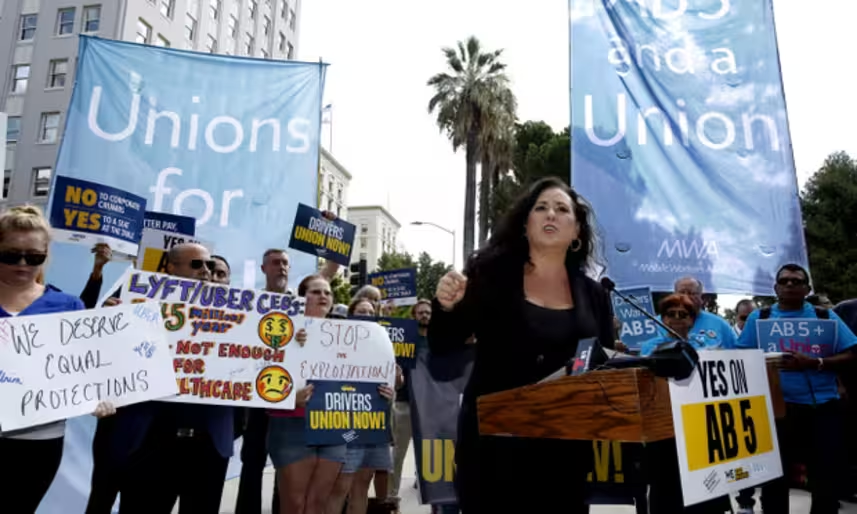
It’s nearly impossible to imagine the world today without the gig economy. The rise of the gig economy has fundamentally reshaped how millions of people work. From driving for Uber to delivering food for DoorDash, gig work brought something to the table that traditional jobs couldn’t—quick, on-demand, well-paying work without the long-term commitment, that too on your own terms. It has, however, imposed pressure on governments, who are now grappling with how to regulate these platforms and protect workers’ rights. The heart of this struggle is rooted in one question: Are gig workers employees? Or their own contractors? Perhaps a combination of both? This legal conflict not only determines the future of gig employment, but also what employment is defined as.
The core issue oscillates around what to classify gig workers as. Traditionally, workers are classified as employees. Therefore, they are rightfully entitled to multiple benefits and have laws put in place for their protection, such as health insurance, minimum wage, workers’ compensation, and unemployment protections. But independent contractors don’t receive these benefits, so the companies using them save on labor costs and avoid regulatory requirements.
In the gig economy, most workers are classified as independent contractors, leading to a wide array of lawsuits and legislative battles in countries all over the globe. Gig companies argue their business model is reliant on the flexibility of workers who act as independent contractors, therefore needing to provide zero benefits to them. Contrastingly, workers claim this classification leaves them without protections of any kind, allowing their exploitation.
There have been multiple high-profile legal battles that have ensued over this issue. In California, Assembly Bill 5 (AB5) was brought in to address the rising concerns regarding gig workers being vulnerable to exploitation. AB5 established a rigorous test for classifying workers as independent contractors, its goal being to reclassify most gig workers as employees, therefore entitling them to the same benefits all workers receive. Naturally, gig companies were not pleased with this, and the AB5 caused much agitation on platforms like Uber and Lyft. This culminated in Proposition 22, a controversial ballot that allowed gig workers to be independent contractors while still allowing them some benefits like health care money allotments and a minimum wage.
The legal fight isn’t limited to the U.S. In 2021, the UK Supreme Court ruled that Uber drivers should be classified as “workers,” a status that falls between employee and independent contractor. This ruling granted drivers the minimum wage and holiday pay, setting a precedent across Europe. Similarly, the European Union is working on directives to ensure better working conditions for gig economy workers, focusing on clearer worker classification criteria and access to social protections.
So what about the workers? After all, they’re the heart of this legal fight. For them, the gig economy has presented its own unique set of opportunities and challenges. The key attraction of gig employment has always been the flexibility it offers. They may choose when and where they work, allowing them much more control than traditional employment would. For those balancing other responsibilities, such as another job or supporting a family, gig work is invaluable, allowing them to financially sustain themselves without the constraints of conventional employment.
But this freedom doesn’t come without a drawback. Often, gig workers lack job security, access to health care, paid leave, and other protections that employees are legally entitled to. Furthermore, a large portion of gig workers agree their income is unpredictable, as it’s heavily reliant on the ever-fluctuating market. Especially after deducting expenses such as vehicle maintenance and insurance, gig companies don’t provide on account of not technically being employers.
From a corporate perspective, gig platforms have thrived by leveraging the independent contractor model. Uber, DoorDash, and multiple other companies have continuously relied on this classification to reduce labor costs and grow their businesses globally. The government’s attempt to reclassify gig workers as employees would irrevocably alter this business model, rocketing costs and reducing the flexibility that made these platforms attractive in the first place.
As a result, companies have resisted legislative attempts to reclassify workers, arguing that such moves would reduce job opportunities and flexibility for workers who prefer independence. In response to California’s AB5, companies invested heavily in Proposition 22, which became the most expensive ballot measure in U.S. history, highlighting the high stakes involved in this legal battle.
The future of employment law in the gig economy remains unpredictable and volatile. As it grows, so will the legal debates revolving around it. Some experts fight for a “third category” of workers, neither employees nor independent contractors, which would help gig workers obtain certain benefits without completely demolishing the business model. Others want portable benefits that workers can use throughout various gig jobs, offering flexibility while ensuring protection.
In the end, the legal framework that surrounds the gig economy must keep evolving to represent the realities of work in the modern age. Whether that’s through reclassification, legislative reform, or creative solutions, the law must accommodate its citizens.
Written by Anushka Sriram


